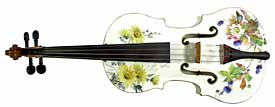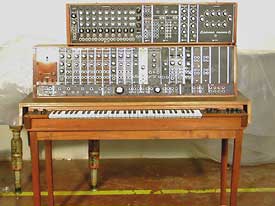Frederick Stearns made pharmaceuticals for a living so others would feel better.
But when Stearns wanted to feel better, he’d spend money on another cherry-red purfling-adorned sitar, or maybe an 1800s harp-piano or a Japanese zither.

In 1899, the successful Detroit businessman and collector of musical instruments donated 940 pieces to U-M. Today, the Stearns Collection of Musical Instruments has grown to include more than 2,200 musical pieces made between 1451-1990. It is one of the largest such collections in North America, far more than the School of Music exhibition space can hold.
That’s why the University stores most of the collection, around 1,960 pieces, in a 50-by-100-foot former camera manufacturing space on the second floor of the Argus II building just west of downtown Ann Arbor. While parts of the collection always are on exhibit, the public never sees the bulk of the collection in one place.
Among several vintage instruments is an upright harp piano. Its black gothic presence evokes visions of medicine show barkers, straw boaters and mustache cups. Across an aisle is a drab gray metal cabinet. It’s doors open to reveal dozens of mandolins and violins in worn black cases. Some mandolins have round-backs; others are flat-backed like modern bluegrass instruments. The violins range from familiar school band types to one creamy-white, gold-edged ceramic violin with flowers painted on top.
“It shows how people want to experiment,” says Joseph Lam, professor and chair of musicology, and Stearns Collection director.

Besides stringed and keyboard instruments there are racks of flutes from around the world; some plain and brown, some with frenetic designs and bodies that flare to bell shapes. A nearly knee-high African xylophone of rugged, dark wood sits across an aisle from a reddish brown fretless Indian tamboura, its long neck nearly pointed at the tuning pegs.
This summer, two student assistants are updating a database of the instruments and the collection’s Web site, at Lam’s direction. Ted Lottman, a professional exhibition designer, comes in fairly regularly to prepare instruments for exhibition, Lam says. That work typically involves cleaning and minor repairs.
While Stearns (1831-1907) was savvy about the pharmaceutical business, passion could overrule his business sense when it came to musical instruments. He bought hundreds on his worldwide travels.
“He was financially more rich than musically know-ledgeable,” Lam explains. “He got conned a little bit.”
In some cases, instruments represented to Stearns as antiques were fakes—something experts who studied the styles of the represented time period would know. Still, Lam says having some fakes in the collection is useful because they serve as cultural artifacts and instruction aides.
Collection presenters have three goals: To preserve the instruments in the collection; to boost knowledge of the range of musical instruments; and to promote diverse world cultures and musics.
Lam says staff members use dehumidifiers when necessary to keep the level of humidity at around 40 percent, which keeps instrument surfaces from getting too damp or dry. Typical room temperature also is maintained.
Also in storage is one of the first Moog synthesizers, circa 1969. “This is a very precious piece,” Lam says.
On the Stearns Web site, Lam has written of the collection’s significance: “Musical instruments are much more than tools for making music. Their distinctive designs and ornamentation not only embody the knowledge and creativity of specific peoples living in particular times and places; they also express their unique aesthetics and values.
“The grand piano, for example, reflects the West’s industrial-technological strength just as an armored vehicle reflects its military might.”
In addition to preserving and exhibiting musical instruments, the Stearns Collection sponsors lectures, presents recital/demonstrations and provides a conduit through which University and community members collaborate to make Ann Arbor a musically and culturally diversified city, Lam says.
The collection’s musical instruments are displayed for the public at the Vesta Mills Gallery, the Conlin Lobby and other exhibition areas in the Earl V. Moore building on North Campus. In addition to support provided by the University and the School of Music, the collection is supported by patrons and volunteers, including the Friends of the Stearns and their “Adopt-an-Instrument” program.
For more information on the Stearns Collection and upcoming events, visit: http://www.music.umich.edu/research/stearns_collection/.

